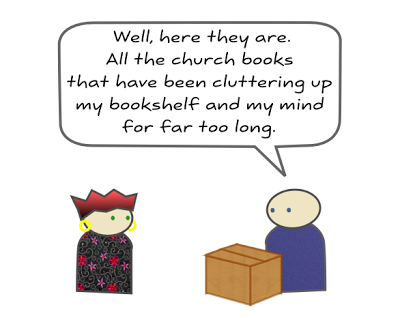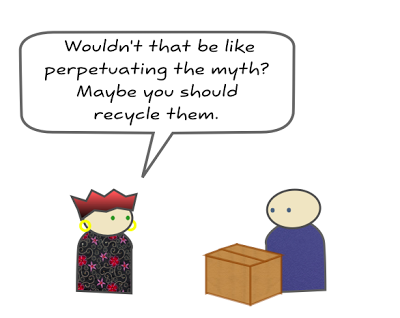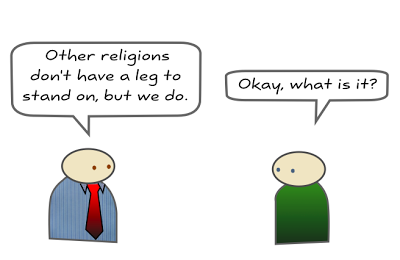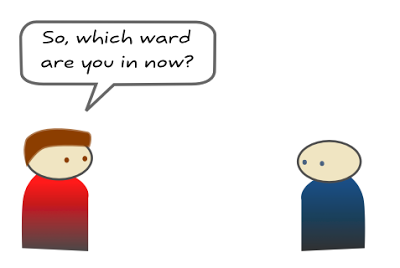Good Reason
It's okay to be wrong. It's not okay to stay wrong.
Category: Mormonism (page 9 of 12)
Michael R. Ash of the Mormon Times has been constructing a case for non-Lehite inhabitants of ancient America. The story is advancing slowly, but it takes a long time to dismantle statements from past church leaders, and to redefine words like ‘true’, ‘correct,’ ‘historicity’ and ‘verisimilitude’.
In case you missed it last time, here’s the problem: If the ‘Lehites’ — Hebrew immigrants to the Americas — were the only ones there, why don’t we see their DNA in current populations? How do we explain the incredible linguistic diversity of the Americas from just a few speakers of Semetic languages? Why don’t Native American languages today appear to have any trace of Hebrew or Egyptian? And as we discussed before, why is Ash having to explain away statements from Church leaders who believed that the land was empty except for the Lehites?
Ash and other LDS apologists have concluded that the land really was inhabited before the Lehites came along. (Which is quite correct, except for the part about the Lehites coming along.) However, the Book of Mormon has some trouble fitting into this model, in part because of the puzzling failure of the Lehites to mention anyone not of Hebrew origin in the Book of Mormon narrative.
In his latest column, Ash gives two possible reasons why the Nephites didn’t mention the ‘other people’ they were surrounded by:
1) the early material from Large Plates — which may have mentioned “others” — was not included in our English translation
This resembles the logic that George W. Bush used when WMDs weren’t found in Iraq: Maybe they’re over there! No? How about over there? Don’t worry, we’ll find ’em someday.
Okay, so the Lehites might have mentioned ‘others’ in the Large Plates. They also might have mentioned potatoes and pumpkins, which they almost certainly ate, but which don’t get a mention in the Book of Mormon. Who knows? It might be true, but it seems a bit (again) prestidigitatious to push the possibility onto a book that no one has access to.
And this is part of the problem with some of Ash’s arguments: they’re terribly speculative. Is it wrong to speculate? Well, no, not always. But Ash is asking us to believe his speculations, having just trashed a lot of speculations by LDS leaders who are much more authoritative than he is. Should we believe Michael Ash, or Joseph Smith? Or I’ve got an idea. How about neither?
and 2) the Small Plates were focused on the ethnogenesis and religious ministry of the Nephite people and would have been unconcerned with any “others” in such a narrative.
Hmm. Tell me more.
From a close reading of the Book of Mormon text, we find that Nephites and Lamanites were sociopolitical names. The Book of Mormon writers were Nephites, and virtually everyone else is referred to with the exonym Lamanite (the term “Lamanite” will be discussed in greater detail in the near future).
Well, I am impressed with the word ‘exonym’. Should be a corker if I can use it in Scrabble on a triple word score. And I can’t wait for him to redefine ‘Lamanite’. Perhaps it will mean ‘person with no DNA whatsoever’.
But I’m getting away from the point. Ash (and now-frequent commenter Seth R.) are arguing that the Lehites didn’t really care so much about the hoards of original inhabitants around them. They never wrote about them because they weren’t in the habit of writing about people not of their group. You know how ethnocentric those ancient people were! (Oh, you don’t? I’m betting Seth and Mr Ash don’t either.)
Of course, this is flat wrong. Lehites in the Book of Mormon do in fact run into other people, and write about them. They run into the ‘people of Zarahemla‘ (which Latter-day Saints now call Mulekites), who allegedly came from bible lands in a different group from the Lehites.
Mulekites, for their part, also encountered and wrote about someone not of their own tribe: Coriantumr. He was supposed to be a decendant of the Jaredites, also allegedly from the Middle East.
So people in the Book of Mormon do find and write about people not of their own immediate group. But they never encounter any of the real native inhabitants of the Americas, like we’d expect them to. They just keep bumping into people from the Middle East. (What are the odds?) And why? I think it’s because the author of the Book of Mormon really was advancing a hypothesis that the Hebrews were the only ones there. The Book of Mormon is an origin myth, attempting to explain how people got to the New World. A hundred and fifty years ago, the idea that they came from the land of the Hebrews was a plausible hypothesis, but the idea has been thoroughly dismanted by a century of evidence from archaeology, anthropology, genetics, and linguistics.
Notice once again that Ash doesn’t advance any testable notions of where Lehites were. He doesn’t have to. All he has to do is blur things so that his preconceived conclusion could be true. Maybe it is true. Maybe not. As long as it preserves the faith, what does it matter?
Let’s move on. The next part is genius.
Another of the weaknesses of the Book of Mormon is that it postulates an absurdly fecund population model once the Lehites arrive. There’s no way you could have as many people as the Book of Mormon claims from just the Lehites. But watch the jiu jitsu: Ash uses this problem to cancel out the problem of the invisible ‘others’!
Within 15 years, Joseph and Jacob were made priests and teachers “over the land of my (Nephi’s) people” (2 Nephi 5:26). We read that within 25 years of their New World arrival, the Nephites were at “war” with the Lamanites. What kind of “war” could possibly exist with the few adults that may have been around without the infusion of pre-existing cultures?
Fifteen years later, some of the Nephite men began desiring “many wives and concubines” (Jacob 1:15). How many women could there have been if there were no others besides the original Lehite party?
…
By about 200 B.C. “corn” (American maize) is mentioned as the grain of preference among the Lamanites (Mosiah 7:22, 9:14). Corn, a uniquely American grain, could not have been brought from Lehi’s world and could not have been discovered wild upon arrival because of its complex cultivating techniques that will only reproduce new corn with human care. This strongly implies that others already were cultivating corn and taught the technique to Book of Mormon peoples.Beginning about 500 years after the Lehites arrived, we read about “thousands” or even tens of thousands of warring soldiers. Such a rapid population growth would not have been possible without the presence of “others.”
This is amazing stuff. I wonder if I could try that.
You know how people criticise the Book of Mormon for containing the word ‘adieu‘? Of course, Joseph Smith could have used any French words he knew when translating, but I have a better answer. French speakers might have migrated to ancient America, swimming over on horses, which is why Book of Mormon people had them. After all, it must be trivial to migrate from Jerusalem to some undefined point in North/South/Central America. The Book of Mormon describes it happening on three separate occasions, so it could have happened again. There’s nothing you can’t do as long as you have the Lord, and enough barley for your swimming horse.
People say that the use of swords and cimeters in the Book of Mormon is anachronistic. But they haven’t considered the real source of swords and cimeters: the post-mortal Paul, who might have minstered unto the Lehites through time travel. Here he distributed cutlery unto the Lehites, and also gave his famous (through eerily New Testamental) discourse about charity, which eventually filtered down to Moroni.
Damn, I hope Ash is getting paid for this. It’s hard work. Doing apologetics with this kind of material, I mean. Well, that and getting paid for something that others would gladly do for free.
UPDATE: It occurred to me that Paul didn’t have to be ‘post-mortal’ if he had a time machine. He could have been alive when he handed the scimeters to the Lehites (and subsequently collected them so as not to leave evidence). But whether he was alive or not at the time hasn’t yet been revealed. It must not be important for our salvation. As always, prayer is the only way to really be certain of my conclusions, like I am. Really certain.
In recent weeks, the term ‘Anti-Mormon’ has been applied to me. I think this is a mislabeling. I’m not ‘an anti-Mormon’. Here’s why.
1. I’m not anti-Mormon in particular, I’m anti-Every-Religion. I take a contrary view on all religions because they’re non-empirical systems. They get their data not from real-world observation, but from revelations. Maybe something good can come from that once in a great while, but it ain’t knowledge. Science leads to knowledge.
2. The label ‘Anti-Mormon’ is used by Mormons to dismiss critical arguments instead of dealing with them. ‘Oh, you’re anti.’ There. Done. It’s usually assumed that the ‘anti’ is irrationally and implacably ‘anti’, and…
3. I’m not. I’m critical of religious views (Mormon and otherwise) up to the very second that they offer evidence for their claims. In most cases they can never do this because the claims aren’t falsifiable (like ‘god exists but he’s hiding from you’). But I’m still open to evidence on the claims that are falsifiable.
My duty as a critical thinker is to keep the door open. Which is why I do this blog. Anyone can come and provide the evidence that will change my mind. And I’ll do it. I’ve changed my mind before, you know. I will go wherever the evidence leads. But it’s not leading there.
I’ve been reading the work of one Michael R. Ash, an apologist with the Mormon Times. He may have overcome ‘shaken faith syndrome’, but he’s made the mistake of embracing the more dangerous ‘True Believer syndrome’ — a troublesome but common condition that involves the epistemological gymnastics you perform when you’ve decided to defend a belief system no matter what, instead of trying to find out what’s actually true.
In his latest posting, he tries not to advance a theory of Book of Mormon geography — that would require the use of pesky facts — but instead to dismiss inaccuracies in Book of Mormon geography. The title: ‘Dismissing Book of Mormon geography inaccuracies‘.
One issue that relates in important ways to Book of Mormon geography is the human composition of the ancient Americas. The traditional LDS folk-belief asserts that the Lehites arrived to a nearly vacant New World, with the possible exception of some Jaredite survivors and the Mulekites. This tradition implies that virtually all Native Americans are descendants of exclusively Book of Mormon peoples.
Folk-belief. I remember LDS folk-belief, but it was always stuff like “If you’re fat, you’ll be resurrected as a fat person.” or “An elephant’s spirit looks like an elephant.” Can it still be folk-doctrine if it’s in the scriptures? Or taught by Joseph Smith, or someone else that you could be accused of apostasy if you ignore. Well, to Mr Ash, if a prophet said it, and then reality contradicts it, the prophet wasn’t wrong — it was ‘folk-belief’ all along.
I must say, I find his approach a bit prestidigitatious. Like cherry-picking in reverse.
Okay, so how did Mormons get the silly idea that place was vacant except for migrating Hebrews?
1. The Book of Mormon narrative never mentions anyone but the putative Hebrew inhabitants. If the place was crawling with people before any Hebrews arrived, the Mulekites and Nephites never ran across them.
2. The Book of Mormon explicitly states that the knowledge of the land was kept from other people.
And behold, it is wisdom that this land should be kept as yet from the knowledge of other nations; for behold, many nations would overrun the land, that there would be no place for an inheritance.
3. Church leaders taught it. Two examples of many:
“We beleive that the existing Indian tribes are all direct descendants of Lehi and his company, and that therefore they have sprung from men all of whom were of the house of Israel.”
– Apostle James E. Talmage, The Articles of Faith, p.293“With pride I tell those who come to my office that a Lamanite is a descendant of one Lehi who left Jerusalem some 600 years before Christ and with his family crossed the mighty deep and landed in America. And Lehi and his family became the ancestors of all of the Indian and Mestizo tribes in North and South and Central America and in the islands of the sea, for in the middle of their history there were those who left America in ships of their making and went to the islands of the sea.” Spencer W. Kimball, “Of Royal Blood,” Ensign, July 1971
Were they wrong? Mormon apologists like Ash would like us to think so (and in fact I agree, but for different reasons). But if Mormon leaders are considered to be authoritative on many other matters pertaining to Mormon doctrine, doesn’t it seem a bit convenient to downplay only some of the things they say just because they’ve been refuted by evidence?
Back to the article.
Early American settlers were fascinated with the fact that the New World was already inhabited by indigenous people. From where did these people originate? A number of frontiersman theorized that the Indians were remnants of the ten lost tribes of Israel. At first blush, this theory seemed to fit fairly well with the overall story of the Book of Mormon, however, the Book of Mormon peoples did not purport to come from any of the “lost tribes.“
More sleight of hand. It’s true that the Book of Mormon doesn’t say they’re from the ‘lost tribes’, but it does say that they’re Hebrews. And if that’s the case, why don’t we see (for example) Hebrew or Egyptian writing on artifacts, any evidence of sacrifices pertaining to the Mosaic law, or any evidence from genetics, linguistics, anthropology, or archaeology?
If Mr Ash wants to do something useful and advance knowledge, he can come out and give his list of the most likely candidate sites for any aspect of Book of Mormon geography, according to the best evidence we have. If he can get his work published in a peer-reviewed journal, so much the better. But I doubt he will. Apologists don’t try to advance ideas. They just try to hide from the facts, take refuge in uncertainty, sing the faithful to sleep, and scrub the record of any statements from authorities that have turned out to be wrong.
I’m here at BYU-Idaho with M. Russell Ballard, a Mormon apostle. Elder Ballard, I was wondering if you could give me some words of wisdom that would help me in my mortal probation.
“I want to try to pull this together, not to frighten you but to wake you up,” Elder Ballard said. “We’ve got to be so solidly anchored in our testimonies of the gospel of Jesus Christ that, regardless of what may come next, we will not waffle; we will stand firm in our belief; we won’t question the doctrines that are part of our belief.”
Not question doctrines or beliefs. Got it.
I do have one question though, and that’s the LDS stand on gay marriage. Why is it so important for us to fuck around with the marital status of other people?
“It’s a pretty simple answer,” Elder Ballard responded. “God created this world and He put Adam here and He gave Adam a helpmate whom he called Eve. They had a charge and a responsibility to multiply and replenish the earth. It is a marvelous and glorious experience to bring forth children and have a family, and that is done between a husband and a wife who are married.”
Um. Do you have an answer that doesn’t involve fictional beings?
“I’m telling you what the Savior said would be the signs of the acceleration towards that day when He shall come,” he said. “We could stay here for a couple of hours talking about all of the prophecies of what will occur in the last days. We’re in the last days — you can quote me on that. And it is moving more rapidly.”
Wow, thanks, Elder Ballard! For a moment there, I was thinking calmly and rationally. Now I’m so scared, I’m ready to believe anything if it just makes the fear go away.
By the way, how long has it been the Last Days? Are we now in the ‘lasty-last days’? Don’t look at me like that, Elder Ballard, I’m just kidding.
So in summary, Don’t question, and be very afraid. That’s all for now. Keep praying, paying, and obeying!
If you take it upon yourself to argue with Christian creationists, you have to know the regular stuff: biology, the second law of thermodynamics, flood hydrology, DNA, optics, embryology.
But if you decide to take on Mormon apologists, you have to have a passing knowledge of all of the above, plus archaeology, linguistics, and Meso-American metallurgy. There’s just no telling what they’ll throw into the mix.
I’ve just discovered Mormon Times writer Michael R. Ash. He makes money as an apologist for FAIR, a Mormon confabulation factory. His job is to disguise the lack of evidence for Mormon doctrines until the church can safely write them out of the canon. They call it ‘Mormon scholarship’, but ‘Mormon scholarship’ is scholarship like ‘Christian rock’ is rock. In his latest article, he complains about the lack of respect.
Shorter Michael Ash
Countering subversive attacks on Mormon scholarship
It’s so unfair that anti-Mormon scientists ‘poison the well’ by dismissing our arguments out of hand. But their claims are invalid because they haven’t read the Book of Mormon cover to cover.
It makes you wonder why he’s addressing the need for science at all, though, when he also claims that questions of the Book of Mormon’s truthfulness
can only be answered on a spiritual level — through faith, humility and personal study and prayer.
And only by carefully defining words like ‘true’, ‘correct’, and ‘historicity’ so as not to include anything that normal people mean when they use those words.
I’m looking forward to many cobbled-together bad-faith arguments in future.
Even when I’d decided that the claims of the LDS Church were not grounded in reality, it took a while for me to resign formally. It was a big deal, so I didn’t want to rush it. But after about a year of not believing, I decided that it was time to write my Exit Letter.
You see, in the LDS Church, even if you no longer attend, or no longer even consider yourself a Mormon, you are still being counted in the church’s records. (Which are thus a bit inflated.) To no longer be counted, you need to resign formally.
A member of the Stake Presidency (who is also a good friend) was very helpful in the process. He explained that if I wanted to, I could submit a letter of resignation to the bishop of my ward, the bishop would write back asking if I was sure, I could write back and say ‘yes’, and then the matter would go to Salt Lake. There are ways around the rigamarole, but that was direct enough for my purposes.
What follows is the text of my exit letter. I don’t recommend using my letter as a model. Richard Packham has a page with information that you can adapt for your own purposes. An exit letter only has to be a one-sentence deal. But I’m a bit more verbose than that, so I wanted my letter to be a manifesto of sorts. You only get to write one of these, after all! In the end, it was exactly what I wanted to say.
Here’s the letter:
Dear (first name of bishop),
This letter is to notify you that I resign my membership in the Church of Jesus Christ of Latter-day Saints, effective immediately. I’d like to ask you to carry out the necessary paperwork to remove my name from the records of the Church. I recognise that according to Church doctrine this cancels all ordinances I have engaged in, and I have made my choice with that consideration in mind.
This is not a decision that I have made lightly. ‘Being Mormon’ has been a part of my identity throughout my life, and I have made many sacrifices in service of the Church because I thought it was right. The process of ‘deconversion’ has at times been difficult. However, I have also found it to be immensely worthwhile. I have gained the ability to reason without worrying about the presumed opinions of hypothetical beings, and I am better able to enjoy and value every day of this life with the people I love, while still being the moral agent I have always been.
In my youth, the LDS Church instilled in me the highest regard for truth. That was what made it better than other churches — it had the truth, or so I thought. Ironically, it was this regard for truth that led me away from religion in general, and Mormonism in particular. As I became more aware of the scientific method, with its reliance on empirical, real-world evidence, it became clear to me that the Church was promoting an essentially false method for finding truth. Latter-day Saints try to evaluate the truth of an idea by how that idea makes them feel. They try to maintain their belief by having faith-promoting experiences and by bearing testimony to each other. But feelings, experiences, and testimony are not reliable sources of evidence because they are coloured by our tendency to see what we want to see. By contrast, the scientific method requires evidence to establish the truthfulness of claims, and it offers a set of tools that control for our human biases and our tendency for wishful thinking.
Science and religion are opposite and irreconcilable ways of understanding the world. Science does a better job. It offers testable ideas, and makes predictions that are confirmed by experimentation and observation. Religion fails miserably at this, but believers are expected to ‘have faith’ and continue believing anyway. I’m pleased to say that I no longer believe in supernatural beings — gods, angels, spirits, or devils — because there is simply no empirical evidence for the existence of such beings, and there are better explanations for the experiences people claim as evidence. I will be very interested should any good evidence appear in the future, though I find it rather unlikely. In the meantime, I do not wish to be a member of an organisation that promotes a superstitious and magical worldview, of which the LDS Church is only one example.
That said, I’d like to add that my experience with the Church — both inside and outside — has been a largely positive one where I have learned much. I have recently had occasion to speak to someone who was going through the deconversion process in his faith, and I observed that our experiences were very similar, with one exception: his church ostracises its unbelievers. The threat of losing his family and social contacts at a time of great change has caused him an added dimension of grief. I am glad that Mormons do not engage in this tactic, and that my LDS friends are still my friends, though I no longer share their worldview.
Thank you for your timely handling of this matter. I would appreciate if you could confirm when my request has been processed.
Best regards,
Daniel Midgley
In the weeks after posting my letter, I had several enjoyable chats with church leaders, in which I asked if they had any evidence for various Mormon doctrines yet, and they tried to explain why I shouldn’t need any. Sadly, their enthusiasm for these chats waned long before mine did. And then some months later, I received my very own letter from one Mr Greg Dodge in Salt Lake City, informing me I was officially No Longer Mormon. I’m having it framed.
My exit letter reflected my experience in the LDS Church. Yours will no doubt be different. But whatever your circumstances, if you no longer believe in the church, there are some good reasons for making an official resignation. Otherwise, you’re still being counted in their statistics, and as long as you’re on their rolls, the things they do are done with your tacit approval. I found a psychological benefit to having that sense of closure. My status on the outside matched my status on the inside, and that’s a great feeling.
To date, my resignation from the LDS Church is the intellectual accomplishment I’m proudest of. I was able to overcome a lifetime of religious conditioning, centuries of socio-cultural tradition, and millions of years of human perceptual weirdness, with only my mind.
© 2025 Good Reason
Theme by Anders Noren — Up ↑
























Recent Comments